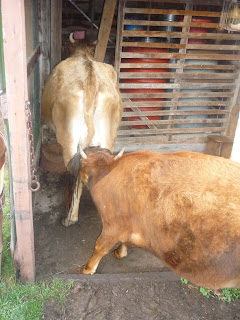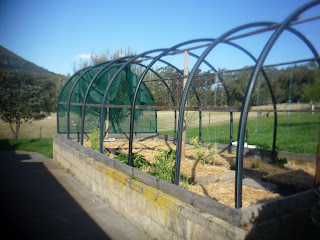We have only a small flock of sheep - mostly self-shedding Wiltshire Horn sheep, but we also have a growing collection of coloured Merino and Crossbred sheep. The Wiltshire Horn ewes are a hardy bunch and normally birth with few complications and are good mothers.
Sometimes however the weaker of twins is rejected and if we find it in time we end up with a poddy. Or a local farmer with a soft heart wants to keep an orphaned lamb alive but hasn't the time to raise it.
Larger scale sheep farms often have a set-up with a designated pen and buckets with multiple teats to raise a commercially worthwhile number of lambs. We start off with a large cardboard box in front of the fire. As long as you put some bedding in it and don't keep the lamb in there so long the urine soaks the bottom out, it works well.
The most important thing for a newborn lamb is drinking some colostrum - the initial milk which is filled with antibodies, fat and protein to protect the newborn. If your poddy lamb did not get any of this from its mother then its chance of survival is lower.
We try to keep some calf colostrum in the freezer for such emergencies (cross species colostrum is way better than no colostrum). If you haven't any, try a local dairy.
In spring our local supermarket stocks plastic teats suitable for lambs. If desperate a baby's teat will do but lambs need a much longer teat to be able to suck it comfortably without assistance.
The teats can be carefully stretched over any sort of glass bottle. We started off with a 330ml juice bottle and have moved on to a 750ml ginger beer bottle. Only for the first 24 hours do lambs need four feeds, then for two weeks it is three feeds so we found it worked with 7am, 2pm and 9pm and wasn't too disruptive.
If you have a milking cow you could feed them your excess otherwise you will need some formula. Our local farm store sells a premium milk replacer designed for lambs. One 16kg bag will feed two lambs to weaning. The instructions about how much to use is given on the packet. I boil the kettle, put the approximate number of scoops in the measuring jug and pour in water to about a third of the total volume required. This is topped up with cow's milk but it could be tap water. This works out at a warm temperature suitable for a young lamb.

Lily the Wiltshire Horn poddy in the enclosure on the verandah.
Once the cardboard box in front of the fire is heading beyond its use by date I build an enclosure. This year it was on the front verandah and used a corner as two walls and two large wooden sheets as the other two. A toybox and a desk were used to hold it together. Here I have to confess that the my teenage daughter, in her role of designated bottle feeder, managed to overbalance and collapse my enclosure on herself without hurting the lamb but breaking her arm in the process. While this was a distinct pain for her the consequence of my hasty construction was not having assistance with the feeding!
This enclosure needs some plastic on the base to trap the urine and plenty of fresh bedding, which will need regular changing.
I also made an outdoor enclosure. We have two dogs that like to pester lambs so it needed to be dog proof and mobile. This was made from a 6m length of pig fencing surrounded by some chook netting.
Lily and Alice (a crossbred) in the outdoor enclosure.
After three weeks the lambs are introduced to the paddock and the rest of the sheep by day and returned to their enclosure at night. They tend to hang by the gate when it is close to feeding times or if I am close but they gradually learn to explore and copy the other lambs in eating grass. By four weeks they stay in the paddock full-time. The quantity of milk is gradually reduced until they are about six weeks old and can feed themselves.
It is quite a responsibility to take on a poddy but children love the soft cuteness of lambs and are often keen to do the feeding. We make sure that new lambs survive three days before we give them a name as that is the danger time. Once you are set up for a poddy it is just part of a routine and an enjoyable way to raise an animal. Having a poddy or two in your flock can also help when you want to move or call the sheep.

















































